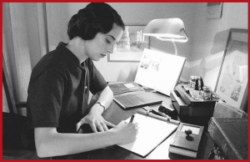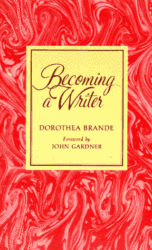The first step toward being a writer is to hitch your unconscious mind to your writing arm.
~ Dorothea Brande
Fledgling writers sometimes need an attitude adjustment. And sometimes more experienced writers do, too.
Otherwise, why would bestselling author Hilary Mantel confess that she reads Dorothea Brande’s Becoming a Writer at least once a year?*
There is a sort of writer’s magic [also called Artistic Coma]. There is a procedure which many an author has come upon by happy accident or has worked out for herself which can, in part, be taught.
I first learned of Becoming a Writer years ago when I dashed into an airport bookstore in who-knows-where and spotted a paperback with a simple cover. It resembled something a five-year-old kid deep in salmon-hued fingerpaint would do. Languishing among a number of more spritely tomes, Becoming a Writer nonetheless stood out among the usual beach reads and bodice rippers. I grabbed it, paid, and ran to the loading gate.
Settled into my miniscule seat in coach, I sank into Brande’s no-nonsense, straightforward take on the writing process.
Just who was Dorothea Brande?
She wrote in the 1930s, basing her work on experience gained as a writing teacher in the 1920s. Her approach to writing owed much to the times she lived in, intellectual life permeated by the New Thought Movement and the ideas of Friedrich Nietzsche. Self-help books proliferated, writers reflecting people’s need for self-reliance after the horrors of World War I, the flu epidemic of 1918, and the Great Crash of 1929. Some contemporaries of Brande include Dale Carnegie, Ayn Rand (Russian-born Alisa Rosenbaum), and Brenda Ueland.
Becoming a Writer predates Ueland’s If You Want to Write by two years, appearing in 1934. And Brande, like Ueland, doesn’t focus on commas, semi-colons, or any of the tricks of the trade usually discussed in books about writing.
Why is her book still important?
The key to writing, Brande suggests, lies in “cultivating a writer’s temperament.” In every writer, two beings co-exist. One approaches the world with an “innocence of eye,” filled with childlike wonder at the world’s marvels, tuned into their subconscious. The other embodies the practical, the critical, and the artisan, living in the harsh world of reality. To be a writer—or to engage in any creative endeavor—both of these beings must be in balance. Brande’s take foretells the left/right-brain dichotomy.
Most of the methods of training the conscious side of the writer – the craftsman and the critic in him – are actually hostile to the good of the artist’s side; and the converse of this proposition is likewise true. But it is possible to train both sides of the character to work in harmony, and the first step in that education is to consider that you must teach yourself not as though you were one person, but two.
Brande subscribes to a Jungian view of the human psyche and applies it to the writer’s mind. Nowadays, experts call this “mindset.” In other words, until a writer faces these issues of balance, they will not benefit much from technical training focusing on the how-to rules of writing.
According to Brande, four issues specific to writers need attention:
The Difficulty of Writing at All
The “One-Book” Author
The Occasional Writer
The Uneven Writer
And that’s why her book stayed on my shelves when, in a fit of pandemic cabin fever last year, I hauled most of my precious books to the local Friends of the Library Book Sale.
One of the most important lessons I gleaned from Brande’s book stemmed from the practice of daily writing, before the sun came up, in the darkness, alone, my desk lit only by the gleam of my computer’s monitor.
To reiterate, what you are actually doing is training yourself, in the twilight zone between sleep and the full waking state, simply to write.
Those who have worked their way through Julia Cameron’s The Artist’s Way will recognize this practice, which Cameron calls “morning pages.” I’ll confess I often slacked off, choosing instead to read rather than write.
 However, in getting words from my brain (subconscious) and onto paper/screen, that “early morning writing” helped me with Brande’s next step: “writing by agreement.” Self-imposed deadlines, appointments with myself to write, not to be broken for anything. No laundry, no floor scrubbing, no dallying, no impromptu trips to the grocery store. Butt in chair, as Anne Lamott so bluntly states.
However, in getting words from my brain (subconscious) and onto paper/screen, that “early morning writing” helped me with Brande’s next step: “writing by agreement.” Self-imposed deadlines, appointments with myself to write, not to be broken for anything. No laundry, no floor scrubbing, no dallying, no impromptu trips to the grocery store. Butt in chair, as Anne Lamott so bluntly states.
Brande insists these two things—“morning writing” and “writing by agreement”—will propel yearning writers forward, toward becoming the writers they dream of being.
But sometimes Brande’s words sting:
If you fail repeatedly at this exercise, give up writing. Your resistance is actually greater than your desire to write…
She goes on to say something else that screams Truth:
But then comes the dawning comprehension of all that a writer’s life implies: not easy daydreaming, but hard work at turning the dream into reality…not writing a few pages which will be judged for style or correctness alone, but the prospect of turning out paragraph after paragraph and page after page which will be read for style, content, and effectiveness.
A key takeaway from Becoming a Writer, then, lies in the need to establish discipline and priorities. This will be different for every writer.
The unconscious is shy, elusive, and unwieldy, but it is possible to learn to tap it at will, and even to direct it. The conscious mind is meddlesome, opinionated, and arrogant, but it can be made subservient to the inborn talent through training. By isolating as far as possible the functions of these two sides of the mind, even by considering them not merely as aspects of the same mind but as separate personalities, we can arrive at a kind of working metaphor, impossible to confuse with reality, but infinitely helpful in self-education.
I still find Brande’s book an excellent way to pick myself up off the floor when I’m feeling blue about writing. When I’m at loose ends, discouraged by rejection. When I wonder why I don’t just play bridge all afternoon instead of writing. At moments like that, I take a busman’s holiday, seeking wordless activities. Brande suggests knitting, fishing, playing solitaire, or just lying in the grass staring at clouds. These forays into solitude provide fertile soil for ideas to flourish and flower.
Writing calls on unused muscles and involves solitude and immobility.
But not all is roses.
Brande’s prose comes across as old-fashioned in spots. She uses exclusively male pronouns and includes longer sentences than is the norm today. And I feel a bit squeamish in knowing that this brilliant woman married Seward Collins, the wealthy editor of The American Review, a Fascist-leaning publication that ran between 1933 and 1937.
Separating a writer from her personal life, and from her era, is sometimes a must.
In addition to the wisdom found on every page of Becoming a Writer, I love Brande’s delicious bibliography of now-vintage books on writing, many published in the early years of the twentieth century. She ends with a chapter of “Prosaic Pointers,” meant to ease the time spent at the desk. Coffee plays an important role!
Despite all of Brande’s encouraging words and techniques, I couldn’t always quell my inner critic. Hilary Mantel named her inner critic “Nigel.” I called mine Alfie. Alfie still acts up more than I like, injecting his long, pointed nose into my business when he shouldn’t.
And, thanks to Alfie, no matter what I did—writing morning pages, taking time to be alone, daydreaming, setting deadlines for myself—I still lacked something: the courage of my convictions.
________________________
This post is the second of four about books that encouraged me to take myself seriously as a writer.


Joan
Thanks, Cindy.